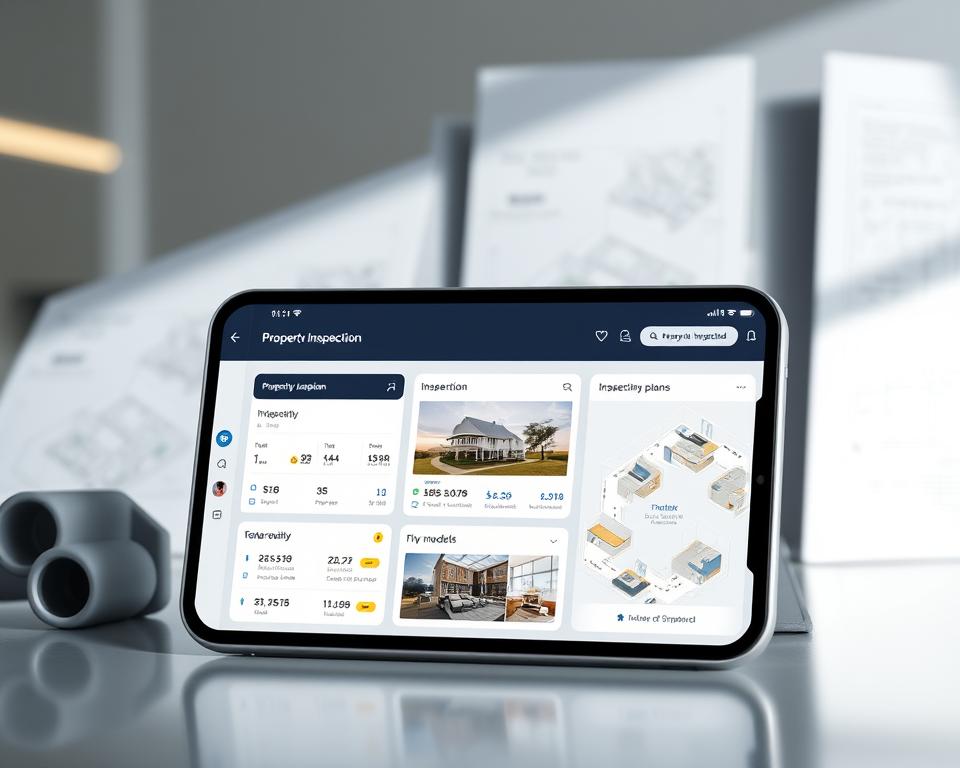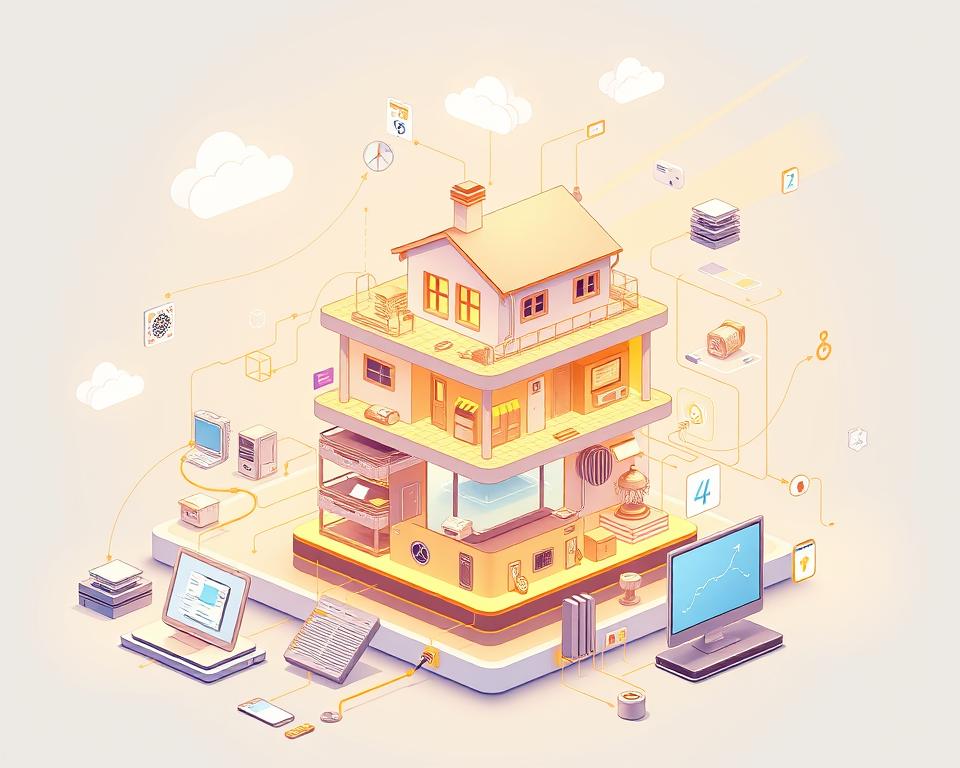Creating a property inspection app is a big task. It needs careful thought about key features, technical needs, and how to make money. A Property Inspection & Home Valuation App can change the real estate game. It helps buyers, sellers, and agents make better choices.
In this guide, we’ll cover what’s important for a Property Inspection & Home Valuation App. We’ll talk about a user-friendly design, strong tech, and marketing. Knowing what users want and adding the right features is key to success.
Table of Contents
Key Takeaways
- Developing a Property Inspection & Home Valuation App requires careful consideration of key features and technical requirements.
- A well-designed property inspection app can streamline the process of evaluating properties.
- A user-friendly interface is essential for a successful property inspection app.
- Effective marketing strategies are crucial for promoting a property inspection app.
- Understanding the needs of the target audience is vital for creating a successful property inspection app.
- A property inspection app can provide a comprehensive solution for property buyers, sellers, and agents.
- Developing a Property Inspection & Home Valuation App can be a game-changer in the real estate industry.
Understanding the Real Estate Tech Revolution
The real estate industry is changing fast, thanks to real estate tech. New tech is changing how we manage, buy, and sell properties. At the heart of this change is property management software, making things more efficient.
The need for digital solutions is on the rise. This has made the real estate tech industry grow quickly. Some big trends include:
- More use of cloud-based property management software
- More demand for mobile apps and online platforms
- Using artificial intelligence and machine learning in real estate tech
Changing consumer habits are also pushing the tech forward. More people are looking for properties online. This means property management software needs to be easy to use. By using these technologies, real estate pros can offer better services, save money, and make customers happier.
Key Features of Successful Property Inspection Apps
Creating a top-notch property inspection app requires careful thought. It should have a simple interface, precise valuation tools, and detailed reports. These elements are crucial for offering dependable home valuation technology to users.
A standout feature of a great app is its ability to give detailed reports. This is made possible by using cutting-edge home valuation technology. Tools like automated valuation models and market analysis help users understand a property’s worth.
- Accurate valuation models
- Comprehensive reporting
- User-friendly interface
- Advanced home valuation technology
By focusing on these features, developers can make an property inspection app that’s both useful and easy to use. This is essential for the real estate industry.
To make a successful property inspection app, focus on giving users accurate and reliable home valuation technology. With advanced features and a simple design, developers can craft an app that’s both effective and user-friendly.
Essential Components of Home Valuation Technology
Home valuation technology is key in the real estate world. It gives fast and accurate property values. This tech uses important parts to give reliable results. It has changed how we value properties, making it quicker and more precise.
Accurate home values come from automated models, market tools, and comparison features. These parts help the tech analyze lots of data and spot trends. It gives users real-time data and insights for better decisions.
Automated Valuation Models
Automated valuation models (AVM) use smart algorithms to look at lots of data. This includes property records, sales, and market trends. AVM gives fair and quick valuations, cutting down on manual appraisals.
Market Analysis Tools
Market tools give insights into current trends. They help users understand what affects property values. By combining these tools with home valuation tech, users get a better market view and make smarter choices.
Comparative Market Assessment Features
Comparative features let users compare properties and see market trends. This is key for understanding value factors and making smart decisions. With these features and home valuation tech, users get a full market view and make accurate valuations.
In summary, home valuation tech’s parts like automated models, market tools, and comparison features work together. They provide fast and accurate property values. This tech has changed the real estate world, helping users make informed choices and grow their businesses.
Technical Requirements for Developing a Property Inspection & Home Valuation App
Creating a property inspection and home valuation app requires careful planning. Mobile app development is key, focusing on making the app easy to use. It must handle tasks like data collection, analysis, and reporting well.
A property inspection app needs a strong backend. This includes a database that can handle lots of data and a secure server for user info.
Here are some important technical needs for such an app:
- Scalability to handle a large number of users and data
- Security measures to protect user information and data
- Data integration with other systems and tools
- Regular updates and maintenance to ensure the app remains efficient and effective
By focusing on these technical aspects, developers can make a useful app. It will help real estate pros and homeowners a lot.
Choosing the Right Technology Stack
When making a property inspection and home valuation app, picking the right tech stack is key. It should support artificial intelligence in real estate and machine learning in property valuation. This makes the app better.
Here are some things to think about when picking a tech stack:
- Frontend development options: Choose a frontend framework like React or Angular. It depends on what the app needs and the team’s skills.
- Backend infrastructure considerations: The backend needs to grow, be safe, and handle lots of data. This includes property listings and user info.
- Database selection criteria: Pick a database that can handle lots of data, query fast, and support the app’s features.
A good tech stack lets the app give accurate valuations. It uses machine learning in property valuation algorithms. It also supports artificial intelligence in real estate to make the user experience better.
User Interface Design Principles
Creating a user-friendly interface is key when making a property inspection app. It’s important for users like property inspectors, real estate agents, and homeowners. A good user interface design greatly improves the app’s usability and user experience.
The aim of user interface design is to make the app easy to use. This means using clear language, simple navigation, and nice graphics. For a property inspection app, the design should let users easily input data, access reports, and view property info.
Some important things to think about for user interface design in a property inspection app include:
- Simple and intuitive navigation
- Clear and concise language
- Visually appealing graphics
- Easy input of data and access to reports
- Customizable interface to meet the needs of different users
By following these principles, developers can make an app that is both useful and easy to use. Effective user interface design is crucial for any app’s success. It’s even more important for a property inspection app, where users handle a lot of data.
Integration of AI and Machine Learning
Artificial Intelligence (AI) and Machine Learning (ML) are key to a top-notch property inspection and home valuation app. They help the app give more precise valuations and improve the user experience. Predictive analytics is vital, letting the app predict property values using past data and trends.
AI and ML are great at analyzing big datasets and spotting patterns that humans might miss. This is super helpful for property analysis. It lets the app consider many factors like location, size, and condition that affect property values.
- Implementing predictive analytics to forecast property values and identify trends
- Using computer vision to analyze property images and identify potential issues
- Developing data processing algorithms to analyze large datasets and provide insights
With these technologies, the app gives users a deeper and more accurate look at property values. It’s a must-have for anyone in the real estate world.
Security Measures and Data Protection
Keeping user data safe is key for a property inspection and home valuation app. It’s vital to have strong security measures to guard against unauthorized access. This means using data encryption, access controls, and secure storage. By focusing on data protection, developers can earn their users’ trust and keep their app safe.
To do this, developers should follow some best practices. For example:
- Implementing end-to-end encryption for data transmission
- Using secure protocols for data storage and access
- Conducting regular security audits and penetration testing
Also, adding security measures like two-factor authentication and secure password storage can boost the app’s safety. By being proactive with data protection, developers can lower the chance of data breaches. This ensures the app’s success in the long run.
By focusing on security measures and data protection, developers can make a safe and reliable app. This improves the user experience and helps the app’s reputation grow. It’s a win-win for both the app and its users.
Mobile-First Development Approach
When making a property inspection app, it’s key to start with a mobile-first development approach. This means designing for mobiles first, not desktops. This way, the app works well on smaller screens.
A property inspection app needs to work well on mobiles. This means thinking about touch screens and small screens. The app’s design and how it feels to use are very important.
Some important things to think about for mobile-first apps include:
- Make the app easy to navigate and use
- Use simple and clear language in the app
- Make sure images and media work well on mobiles
By focusing on mobiles first, developers can make an app that is easy to use and works well. This makes the app a good experience for users.
Testing and Quality Assurance
Ensuring a property inspection app’s quality and reliability is key to its success. Testing and quality assurance are crucial for finding and fixing bugs. They also help improve the app’s performance. A good testing plan can catch errors early, saving time and money, and making users happier.
User acceptance testing is a big part of this. It checks if the app works as it should and meets standards. This ensures the app is easy to use and gives accurate results.
Performance Optimization Techniques
- Regular performance tests to find and fix slow spots
- Using caching to make the app faster and more responsive
- Optimizing database queries for better data handling
By focusing on testing and quality assurance, developers can make a reliable and efficient property inspection app. This app will meet user needs, leading to business growth and success.
Compliance and Legal Considerations
When making a property inspection and home valuation app, it’s key to think about compliance and legal considerations. This includes data privacy laws, real estate rules, and intellectual property rights. It’s important to follow these laws to avoid legal trouble and keep a good name.
Companies like SmartTek offer insights into making these apps. By knowing the legal needs, developers can make apps that are up to standard. Important things to think about include:
- Data storage and protection
- Following real estate rules
- Intellectual property rights
By focusing on compliance and legal considerations, developers can make real estate tech apps that work well. This builds trust with users and helps the app succeed in the long run. As the real estate tech world grows, it’s crucial to keep up with new laws and trends.
For more on the latest in real estate tech, check out Next Big Technology.
Monetization Strategies
Creating effective monetization strategies is key for a property inspection app’s success. It’s important to know what users need and offer something unique. A good way is to use a freemium model. This means basic features are free, but premium ones cost money.
A well-made property inspection app can give users valuable insights. This makes it a great choice for premium features and subscription models. Features like advanced reporting and customized templates can attract users. This way, developers can make money and keep users coming back.
Another strategy is to offer enterprise solutions to big property management companies. This could include special software and support. By focusing on this area, developers can make a lot of money and partner with important industry players. For more tips on making a successful property inspection app, check out nextbigtechnology.
Launch Strategy and Market Deployment
A well-planned launch strategy is key for a property inspection app’s success. It starts with market research to know the target audience and their needs. A good launch strategy creates excitement and draws in early users.
Key points for a launch strategy include:
- Identifying the target audience and their pain points
- Developing a unique value proposition
- Creating a marketing campaign to reach the target audience
A successful launch strategy can be the difference for a property inspection app. Spending time on a detailed launch plan boosts success chances. The launch strategy must fit the app’s needs, considering the competition and audience requirements.
Maintenance and Updates
For a property inspection app to stay useful, it’s key to focus on maintenance and updates. This means adding new features and improving the app regularly. This keeps it competitive and ensures users have a smooth experience.
Some important parts of maintenance and updates are:
- Regularly updating the app’s features and functionality to ensure it remains relevant and useful
- Monitoring the app’s performance to identify areas for improvement
- Integrating user feedback to make improvements and add new features
By focusing on maintenance and updates, developers can keep their property inspection appquote> valuable for users. This leads to more user engagement and positive feedback.
In the end, a successful property inspection app relies on constant maintenance and updates. It’s all about improving and enhancing the user experience.
Measuring Success and ROI
To see how well a property inspection app works, it’s key to watch certain numbers. Measuring success means looking at how users interact, how much money it makes, and how happy customers are. By checking these numbers, developers can spot what needs fixing and make smart choices to improve the app.
A good property inspection app should make users happy, work better, and help make more money. To get there, developers need to keep checking how the app is doing and tweak it when needed. This might mean adding new features, making the app easier to use, or expanding what it can do.
Some important numbers to track for a property inspection app’s success are:
- User acquisition and retention rates
- Revenue growth and conversion rates
- Customer satisfaction and feedback
- App store ratings and reviews
By keeping an eye on these numbers and using them to guide development, developers can build an app that users love and that helps the business grow.
Conclusion
Developing a property inspection and home valuation app is key in today’s real estate tech world. These apps use advanced tools like automated valuation models and AI for better decision-making. They help real estate pros, homeowners, and buyers make smart choices quickly and accurately.
Success comes from making the app easy to use and secure. It must work well on mobile devices. By using the latest tech and following the law, these apps can change how we do real estate. This benefits everyone involved.
The property tech field is growing fast, offering big chances for innovators. By keeping up with new tech and using property apps, real estate pros can improve their work. They can also make customers happier and grow their business.



















